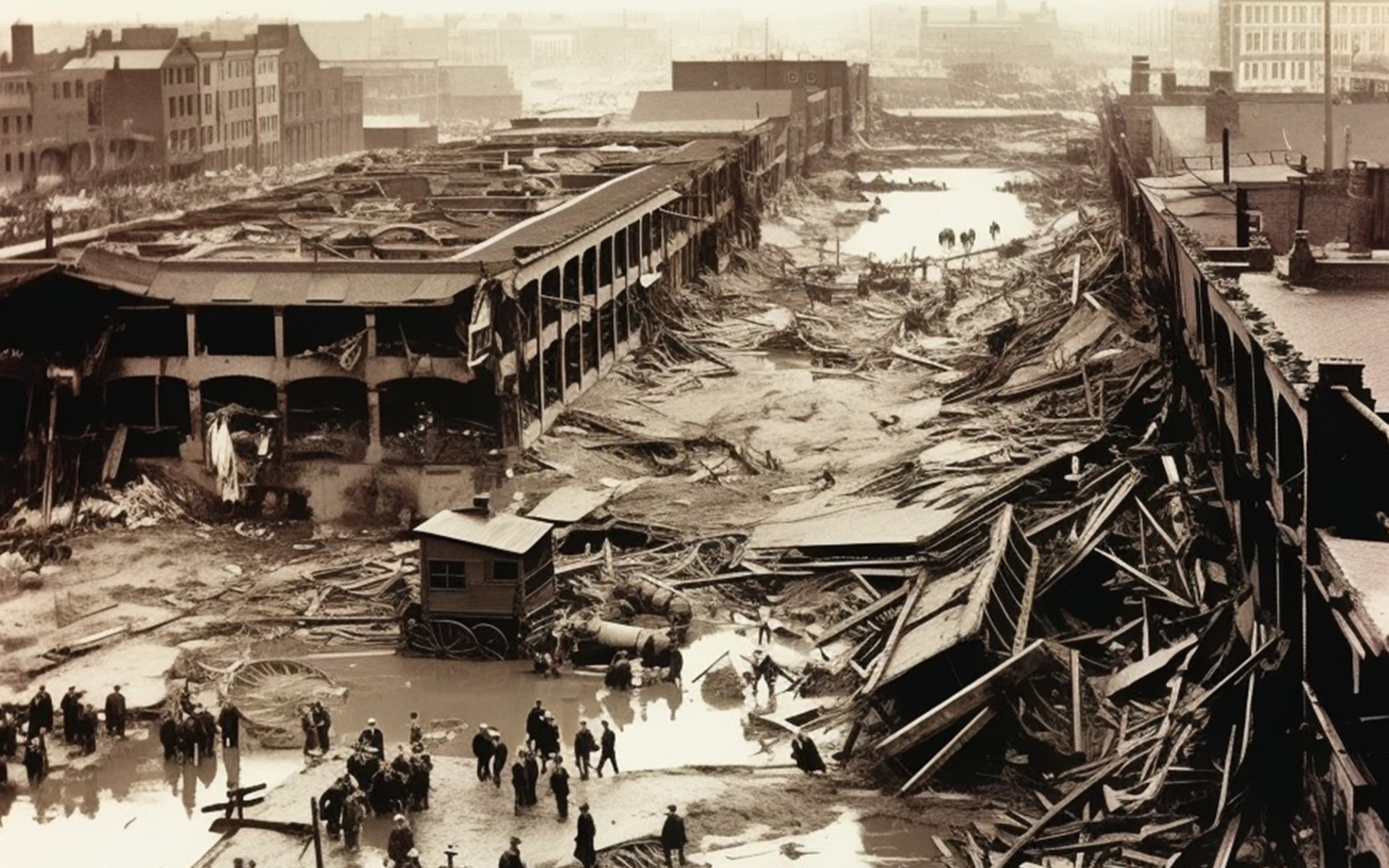The Great Molasses Flood

On a bright January day in 1919, on Commercial Street in Boston, Massachusetts, USA, people were beginning their daily routines. Merchants were hawking their wares, and children were playing cheerfully. No one had any idea that an unexpected disaster born from molasses was about to strike.
The Origin of the Disaster : A Flawed Molasses Tank
The beginning of The Great Molasses Flood stemmed from the Purity Distilling Company, a subsidiary of the United States Industrial Alcohol Company (USIA). This company produced molasses for alcohol and munitions during World War I. During the war, alcohol was in high demand for soldiers, especially rum, which used molasses in its production. Additionally, molasses was also needed to produce ethanol for fuel in military armaments.
Consequently, in 1915, the company hastily constructed a massive molasses storage tank, approximately 30 meters (98 feet) in diameter, capable of holding an enormous 8,700,000 liters (2.3 million US gallons) of molasses (equivalent to three Olympic-sized swimming pools). The construction was rushed and lacked thorough inspection to meet wartime demands. Molasses from the Caribbean was continuously stored and sent for industrial production for four years.
During this period, there were constant groaning sounds of metal, the surface of the tank began to crack, and there were even molasses leaks seeping onto the street. Employees at the factory had warned their superiors and management about the structural abnormalities of the tank. However, only minor repairs were made to plug the leaks. The metallic groaning continued, and local residents, mostly Italian and Irish immigrant families, grew accustomed to the booming sounds and metallic groans emanating from the tank, as if it were a part of their daily lives.
The Moment of Disaster : A Molasses Tsunami
Then, at noon on January 15, 1919, the temperature that day was unusually warm for a Boston winter, though not excessively hot. Commercial Street was bustling as usual. Workers' voices, the clatter of horses' hooves, trains arriving at the station platform, firefighters at Engine 31 station enjoying their lunch and playing cards, a few townspeople gathering firewood near the molasses tank, and night shift workers sleeping in a nearby bar... Everything proceeded peacefully.
But then, at 12:40 PM, the day's tranquility was shattered by the deafening roar of the metal tank, overwhelmed by the immense pressure of the molasses. The tank ruptured, its metal skin tearing open to create a huge void. Molasses surged out, flowing through the narrow streets of the city like a tsunami.
Reports from the Boston Post stated that the outpouring molasses reached a height of approximately 4-12 meters (15-40 feet) and moved at a speed of up to 56 kilometers per hour (35 miles per hour). It destroyed everything in its pathbuildings, houses, vehiclesand swept away countless people, submerging them in the dark, viscous wave.
Moments of Survival and Rescue Efforts
The three townspeople gathering firewood near the incident site were immediately engulfed by the molasses wave. One drowned from suffocation, another died when the wave propelled a streetcar into their body, and the third suffered severe head injuries from colliding with a lamppost.
A bar employee, who had just woken up, found his home collapsing. Before he could regain his bearings, he fell into the molasses wave, nearly drowning. Fortunately, he managed to reach a floating mattress nearby and survived. He was also able to rescue his sister in time, but tragically, his mother and brother perished in the incident.
Help arrived swiftly, with police and naval personnel attempting to navigate the molasses, which resembled quicksand and began to solidify in the cold air. Soon, rescue teams began pulling survivors from the wreckage, including a group of firefighters at Engine 31 station who were trapped inside after the second floor of their building collapsed. Rescuing the firefighters proved difficult due to the dense debris. Eventually, one firefighter succumbed to exhaustion and drowned in the molasses.
Aftermath and Crucial Lessons
The rescue mission continued for several days. The death toll rose to 21 fatalities and 150 injured. This event not only affected people but also structures, trees, and even animals, as the viscous molasses solidified and clung to everything. The clean-up process was incredibly challenging, taking many months to wash away. Even the harbor water remained brown for weeks.
In 1925, the United States Industrial Alcohol Company (USIA) was found liable for the incident and ordered to pay $300,000 (approximately $30 million in today's currency) to the victims and for all damages incurred. This marked the longest and costliest civil lawsuit in Massachusetts history. Furthermore, the incident spurred significant changes in industrial regulations to prevent similar future disasters, emphasizing the importance of structural inspections and safety in construction.
Time passed, and by 1995, the site became a waterfront park. A green and white metal plaque was placed at the original location of the molasses tank, serving as the first and only official memorial for this disaster, a stark reminder of the painful lessons learned from negligence and its devastating consequences.


